2017 NISSAN ROGUE HYBRID tires
[x] Cancel search: tiresPage 37 of 77
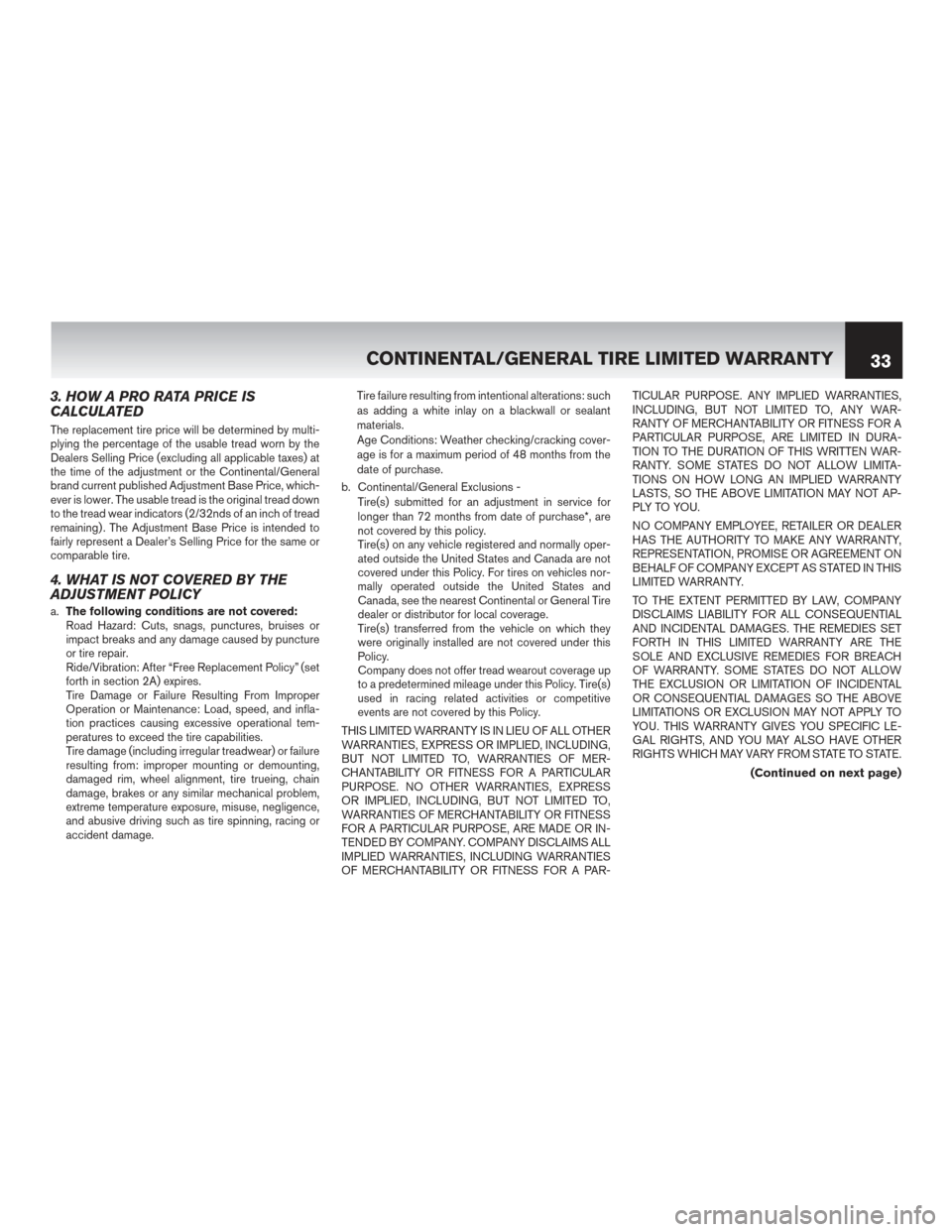
3. HOW A PRO RATA PRICE IS
CALCULATED
The replacement tire price will be determined by multi-
plying the percentage of the usable tread worn by the
Dealers Selling Price (excluding all applicable taxes) at
the time of the adjustment or the Continental/General
brand current published Adjustment Base Price, which-
ever is lower. The usable tread is the original tread down
to the tread wear indicators (2/32nds of an inch of tread
remaining) . The Adjustment Base Price is intended to
fairly represent a Dealer’s Selling Price for the same or
comparable tire.
4. WHAT IS NOT COVERED BY THE
ADJUSTMENT POLICY
a.The following conditions are not covered:
Road Hazard: Cuts, snags, punctures, bruises or
impact breaks and any damage caused by puncture
or tire repair.
Ride/Vibration: After “Free Replacement Policy” (set
forth in section 2A) expires.
Tire Damage or Failure Resulting From Improper
Operation or Maintenance: Load, speed, and infla-
tion practices causing excessive operational tem-
peratures to exceed the tire capabilities.
Tire damage (including irregular treadwear) or failure
resulting from: improper mounting or demounting,
damaged rim, wheel alignment, tire trueing, chain
damage, brakes or any similar mechanical problem,
extreme temperature exposure, misuse, negligence,
and abusive driving such as tire spinning, racing or
accident damage. Tire failure resulting from intentional alterations: such
as adding a white inlay on a blackwall or sealant
materials.
Age Conditions: Weather checking/cracking cover-
age is for a maximum period of 48 months from the
date of purchase.
b. Continental/General Exclusions - Tire(s) submitted for an adjustment in service for
longer than 72 months from date of purchase*, are
not covered by this policy.
Tire(s) on any vehicle registered and normally oper-
ated outside the United States and Canada are not
covered under this Policy. For tires on vehicles nor-
mally operated outside the United States and
Canada, see the nearest Continental or General Tire
dealer or distributor for local coverage.
Tire(s) transferred from the vehicle on which they
were originally installed are not covered under this
Policy.
Company does not offer tread wearout coverage up
to a predetermined mileage under this Policy. Tire(s)
used in racing related activities or competitive
events are not covered by this Policy.
THIS LIMITED WARRANTY IS IN LIEU OF ALL OTHER
WARRANTIES, EXPRESS OR IMPLIED, INCLUDING,
BUT NOT LIMITED TO, WARRANTIES OF MER-
CHANTABILITY OR FITNESS FOR A PARTICULAR
PURPOSE. NO OTHER WARRANTIES, EXPRESS
OR IMPLIED, INCLUDING, BUT NOT LIMITED TO,
WARRANTIES OF MERCHANTABILITY OR FITNESS
FOR A PARTICULAR PURPOSE, ARE MADE OR IN-
TENDED BY COMPANY. COMPANY DISCLAIMS ALL
IMPLIED WARRANTIES, INCLUDING WARRANTIES
OF MERCHANTABILITY OR FITNESS FOR A PAR- TICULAR PURPOSE. ANY IMPLIED WARRANTIES,
INCLUDING, BUT NOT LIMITED TO, ANY WAR-
RANTY OF MERCHANTABILITY OR FITNESS FOR A
PARTICULAR PURPOSE, ARE LIMITED IN DURA-
TION TO THE DURATION OF THIS WRITTEN WAR-
RANTY. SOME STATES DO NOT ALLOW LIMITA-
TIONS ON HOW LONG AN IMPLIED WARRANTY
LASTS, SO THE ABOVE LIMITATION MAY NOT AP-
PLY TO YOU.
NO COMPANY EMPLOYEE, RETAILER OR DEALER
HAS THE AUTHORITY TO MAKE ANY WARRANTY,
REPRESENTATION, PROMISE OR AGREEMENT ON
BEHALF OF COMPANY EXCEPT AS STATED IN THIS
LIMITED WARRANTY.
TO THE EXTENT PERMITTED BY LAW, COMPANY
DISCLAIMS LIABILITY FOR ALL CONSEQUENTIAL
AND INCIDENTAL DAMAGES. THE REMEDIES SET
FORTH IN THIS LIMITED WARRANTY ARE THE
SOLE AND EXCLUSIVE REMEDIES FOR BREACH
OF WARRANTY. SOME STATES DO NOT ALLOW
THE EXCLUSION OR LIMITATION OF INCIDENTAL
OR CONSEQUENTIAL DAMAGES SO THE ABOVE
LIMITATIONS OR EXCLUSION MAY NOT APPLY TO
YOU. THIS WARRANTY GIVES YOU SPECIFIC LE-
GAL RIGHTS, AND YOU MAY ALSO HAVE OTHER
RIGHTS WHICH MAY VARY FROM STATE TO STATE.
(Continued on next page)
CONTINENTAL/GENERAL TIRE LIMITED WARRANTY
33
Page 38 of 77
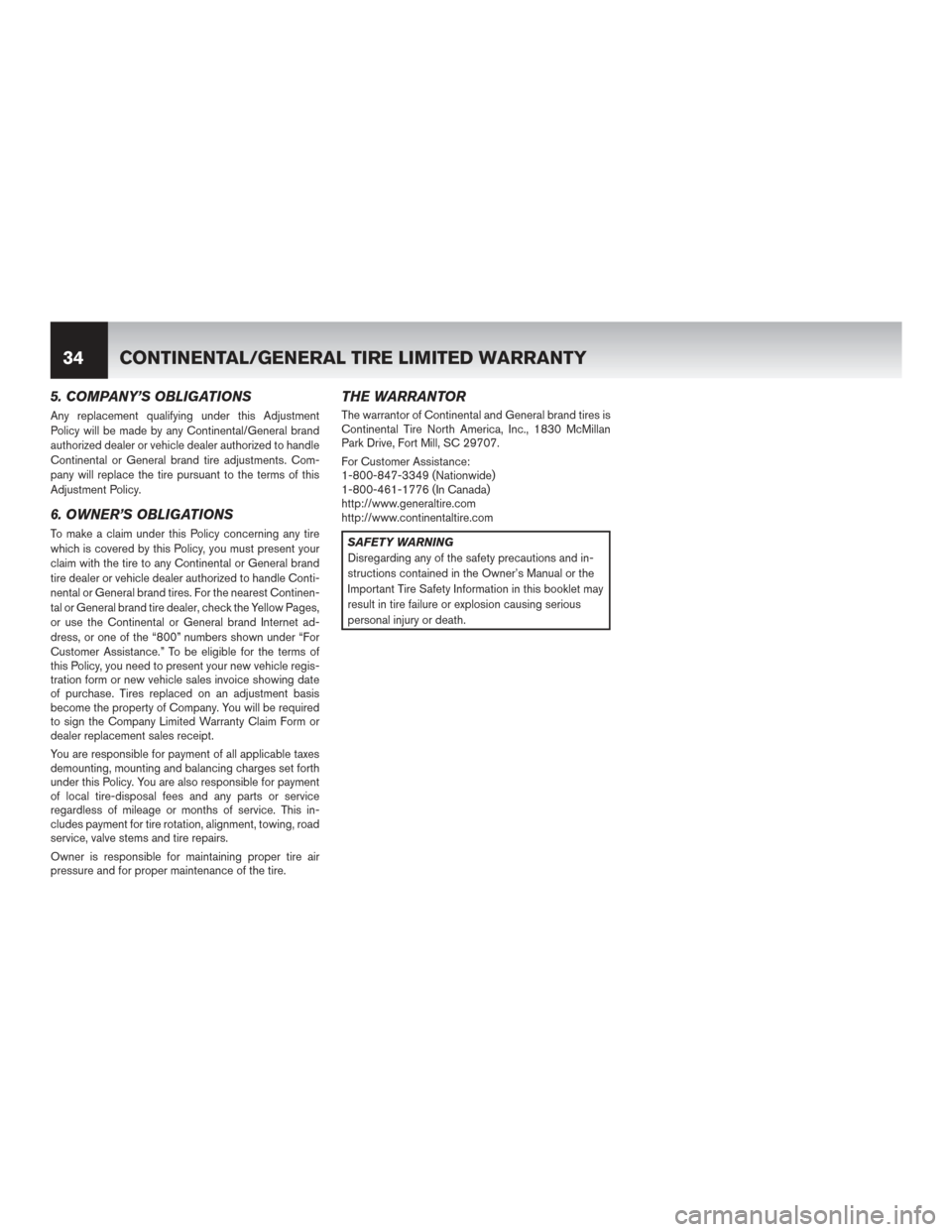
5. COMPANY’S OBLIGATIONS
Any replacement qualifying under this Adjustment
Policy will be made by any Continental/General brand
authorized dealer or vehicle dealer authorized to handle
Continental or General brand tire adjustments. Com-
pany will replace the tire pursuant to the terms of this
Adjustment Policy.
6. OWNER’S OBLIGATIONS
To make a claim under this Policy concerning any tire
which is covered by this Policy, you must present your
claim with the tire to any Continental or General brand
tire dealer or vehicle dealer authorized to handle Conti-
nental or General brand tires. For the nearest Continen-
tal or General brand tire dealer, check the Yellow Pages,
or use the Continental or General brand Internet ad-
dress, or one of the “800” numbers shown under “For
Customer Assistance.” To be eligible for the terms of
this Policy, you need to present your new vehicle regis-
tration form or new vehicle sales invoice showing date
of purchase. Tires replaced on an adjustment basis
become the property of Company. You will be required
to sign the Company Limited Warranty Claim Form or
dealer replacement sales receipt.
You are responsible for payment of all applicable taxes
demounting, mounting and balancing charges set forth
under this Policy. You are also responsible for payment
of local tire-disposal fees and any parts or service
regardless of mileage or months of service. This in-
cludes payment for tire rotation, alignment, towing, road
service, valve stems and tire repairs.
Owner is responsible for maintaining proper tire air
pressure and for proper maintenance of the tire.
THE WARRANTOR
The warrantor of Continental and General brand tires is
Continental Tire North America, Inc., 1830 McMillan
Park Drive, Fort Mill, SC 29707.
For Customer Assistance:
1-800-847-3349 (Nationwide)
1-800-461-1776 (In Canada)
http://www.generaltire.com
http://www.continentaltire.com
SAFETY WARNING
Disregarding any of the safety precautions and in-
structions contained in the Owner’s Manual or the
Important Tire Safety Information in this booklet may
result in tire failure or explosion causing serious
personal injury or death.
34CONTINENTAL/GENERAL TIRE LIMITED WARRANTY
Page 39 of 77
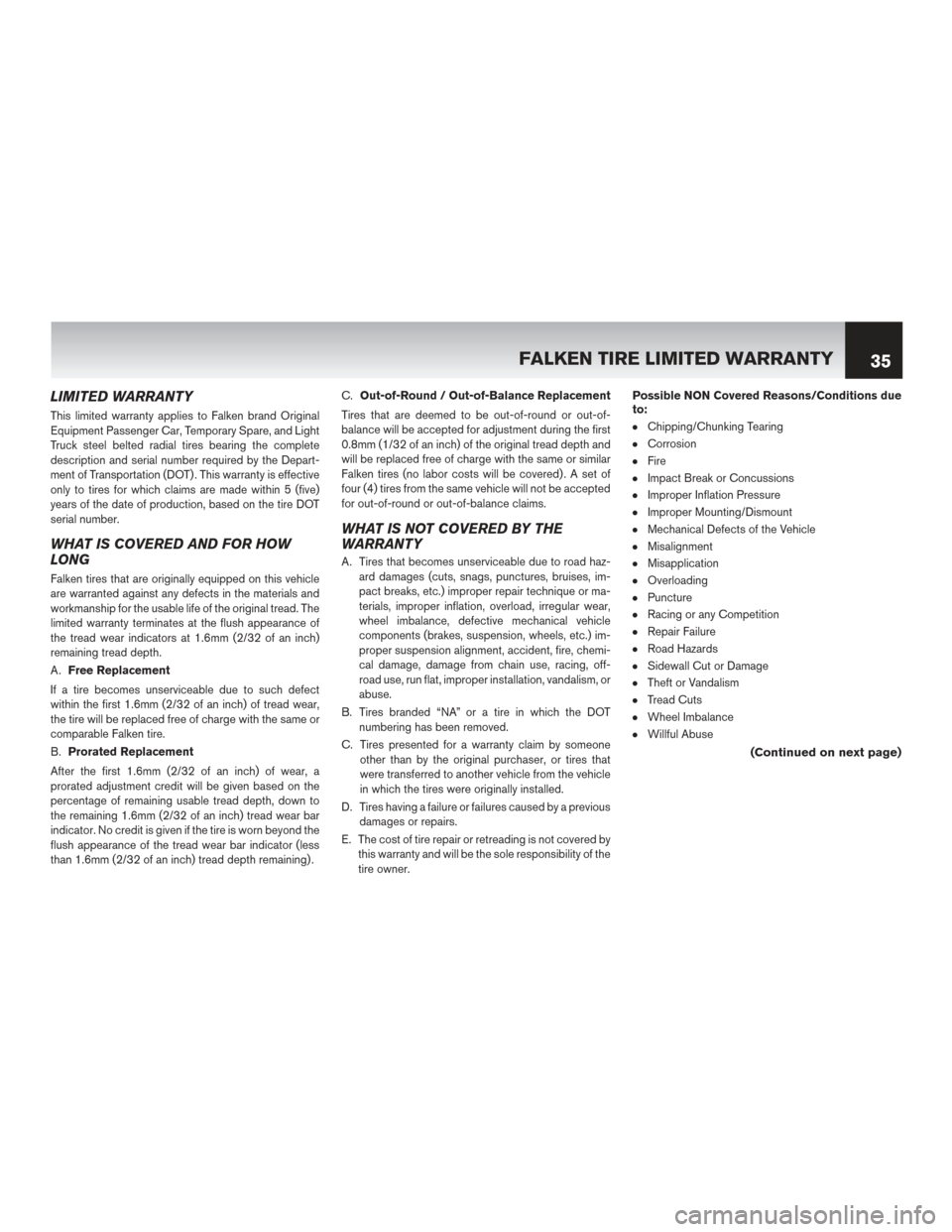
LIMITED WARRANTY
This limited warranty applies to Falken brand Original
Equipment Passenger Car, Temporary Spare, and Light
Truck steel belted radial tires bearing the complete
description and serial number required by the Depart-
ment of Transportation (DOT) . This warranty is effective
only to tires for which claims are made within 5 (five)
years of the date of production, based on the tire DOT
serial number.
WHAT IS COVERED AND FOR HOW
LONG
Falken tires that are originally equipped on this vehicle
are warranted against any defects in the materials and
workmanship for the usable life of the original tread. The
limited warranty terminates at the flush appearance of
the tread wear indicators at 1.6mm (2/32 of an inch)
remaining tread depth.
A.Free Replacement
If a tire becomes unserviceable due to such defect
within the first 1.6mm (2/32 of an inch) of tread wear,
the tire will be replaced free of charge with the same or
comparable Falken tire.
B. Prorated Replacement
After the first 1.6mm (2/32 of an inch) of wear, a
prorated adjustment credit will be given based on the
percentage of remaining usable tread depth, down to
the remaining 1.6mm (2/32 of an inch) tread wear bar
indicator. No credit is given if the tire is worn beyond the
flush appearance of the tread wear bar indicator (less
than 1.6mm (2/32 of an inch) tread depth remaining) . C.
Out-of-Round / Out-of-Balance Replacement
Tires that are deemed to be out-of-round or out-of-
balance will be accepted for adjustment during the first
0.8mm (1/32 of an inch) of the original tread depth and
will be replaced free of charge with the same or similar
Falken tires (no labor costs will be covered) . A set of
four (4) tires from the same vehicle will not be accepted
for out-of-round or out-of-balance claims.
WHAT IS NOT COVERED BY THE
WARRANTY
A. Tires that becomes unserviceable due to road haz- ard damages (cuts, snags, punctures, bruises, im-
pact breaks, etc.) improper repair technique or ma-
terials, improper inflation, overload, irregular wear,
wheel imbalance, defective mechanical vehicle
components (brakes, suspension, wheels, etc.) im-
proper suspension alignment, accident, fire, chemi-
cal damage, damage from chain use, racing, off-
road use, run flat, improper installation, vandalism, or
abuse.
B. Tires branded “NA” or a tire in which the DOT numbering has been removed.
C. Tires presented for a warranty claim by someone other than by the original purchaser, or tires that
were transferred to another vehicle from the vehicle
in which the tires were originally installed.
D. Tires having a failure or failures caused by a previous damages or repairs.
E. The cost of tire repair or retreading is not covered by this warranty and will be the sole responsibility of the
tire owner. Possible NON Covered Reasons/Conditions due
to:
●Chipping/Chunking Tearing
●Corrosion
●Fire
●Impact Break or Concussions
●Improper Inflation Pressure
●Improper Mounting/Dismount
●Mechanical Defects of the Vehicle
●Misalignment
●Misapplication
●Overloading
●Puncture
●Racing or any Competition
●Repair Failure
●Road Hazards
●Sidewall Cut or Damage
●Theft or Vandalism
●Tread Cuts
●Wheel Imbalance
●Willful Abuse
(Continued on next page)
FALKEN TIRE LIMITED WARRANTY
35
Page 40 of 77
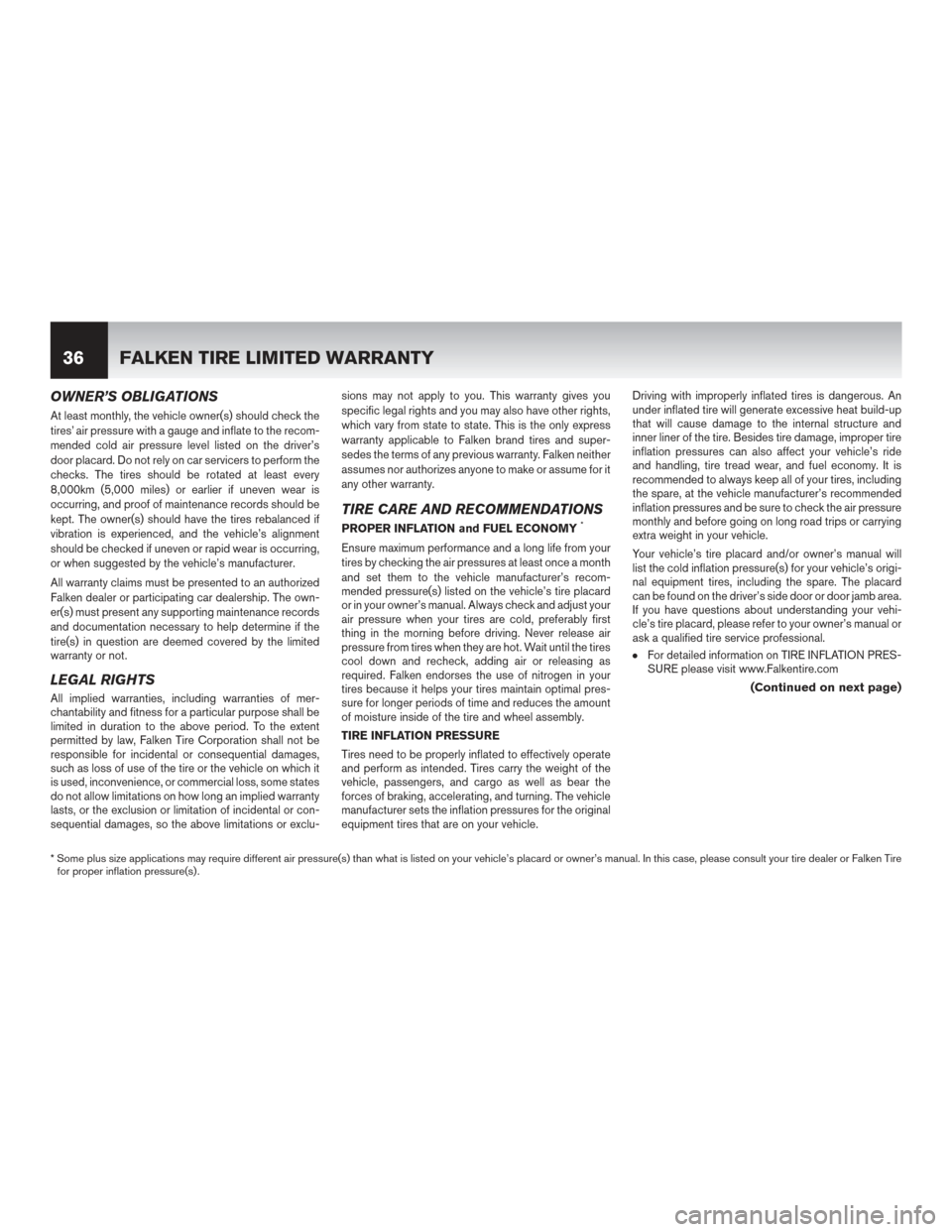
OWNER’S OBLIGATIONS
At least monthly, the vehicle owner(s) should check the
tires’ air pressure with a gauge and inflate to the recom-
mended cold air pressure level listed on the driver’s
door placard. Do not rely on car servicers to perform the
checks. The tires should be rotated at least every
8,000km (5,000 miles) or earlier if uneven wear is
occurring, and proof of maintenance records should be
kept. The owner(s) should have the tires rebalanced if
vibration is experienced, and the vehicle’s alignment
should be checked if uneven or rapid wear is occurring,
or when suggested by the vehicle’s manufacturer.
All warranty claims must be presented to an authorized
Falken dealer or participating car dealership. The own-
er(s) must present any supporting maintenance records
and documentation necessary to help determine if the
tire(s) in question are deemed covered by the limited
warranty or not.
LEGAL RIGHTS
All implied warranties, including warranties of mer-
chantability and fitness for a particular purpose shall be
limited in duration to the above period. To the extent
permitted by law, Falken Tire Corporation shall not be
responsible for incidental or consequential damages,
such as loss of use of the tire or the vehicle on which it
is used, inconvenience, or commercial loss, some states
do not allow limitations on how long an implied warranty
lasts, or the exclusion or limitation of incidental or con-
sequential damages, so the above limitations or exclu-sions may not apply to you. This warranty gives you
specific legal rights and you may also have other rights,
which vary from state to state. This is the only express
warranty applicable to Falken brand tires and super-
sedes the terms of any previous warranty. Falken neither
assumes nor authorizes anyone to make or assume for it
any other warranty.
TIRE CARE AND RECOMMENDATIONS
PROPER INFLATION and FUEL ECONOMY*
Ensure maximum performance and a long life from your
tires by checking the air pressures at least once a month
and set them to the vehicle manufacturer’s recom-
mended pressure(s) listed on the vehicle’s tire placard
or in your owner’s manual. Always check and adjust your
air pressure when your tires are cold, preferably first
thing in the morning before driving. Never release air
pressure from tires when they are hot. Wait until the tires
cool down and recheck, adding air or releasing as
required. Falken endorses the use of nitrogen in your
tires because it helps your tires maintain optimal pres-
sure for longer periods of time and reduces the amount
of moisture inside of the tire and wheel assembly.
TIRE INFLATION PRESSURE
Tires need to be properly inflated to effectively operate
and perform as intended. Tires carry the weight of the
vehicle, passengers, and cargo as well as bear the
forces of braking, accelerating, and turning. The vehicle
manufacturer sets the inflation pressures for the original
equipment tires that are on your vehicle.Driving with improperly inflated tires is dangerous. An
under inflated tire will generate excessive heat build-up
that will cause damage to the internal structure and
inner liner of the tire. Besides tire damage, improper tire
inflation pressures can also affect your vehicle’s ride
and handling, tire tread wear, and fuel economy. It is
recommended to always keep all of your tires, including
the spare, at the vehicle manufacturer’s recommended
inflation pressures and be sure to check the air pressure
monthly and before going on long road trips or carrying
extra weight in your vehicle.
Your vehicle’s tire placard and/or owner’s manual will
list the cold inflation pressure(s) for your vehicle’s origi-
nal equipment tires, including the spare. The placard
can be found on the driver’s side door or door jamb area.
If you have questions about understanding your vehi-
cle’s tire placard, please refer to your owner’s manual or
ask a qualified tire service professional.
●For detailed information on TIRE INFLATION PRES-
SURE please visit www.Falkentire.com
(Continued on next page)
* Some plus size applications may require different air pressure(s) than what is listed on your vehicle’s placard or owner’s manual. In this case, please consult your tire dealer or Falken Tire
for proper inflation pressure(s) .
36 FALKEN TIRE LIMITED WARRANTY
Page 41 of 77
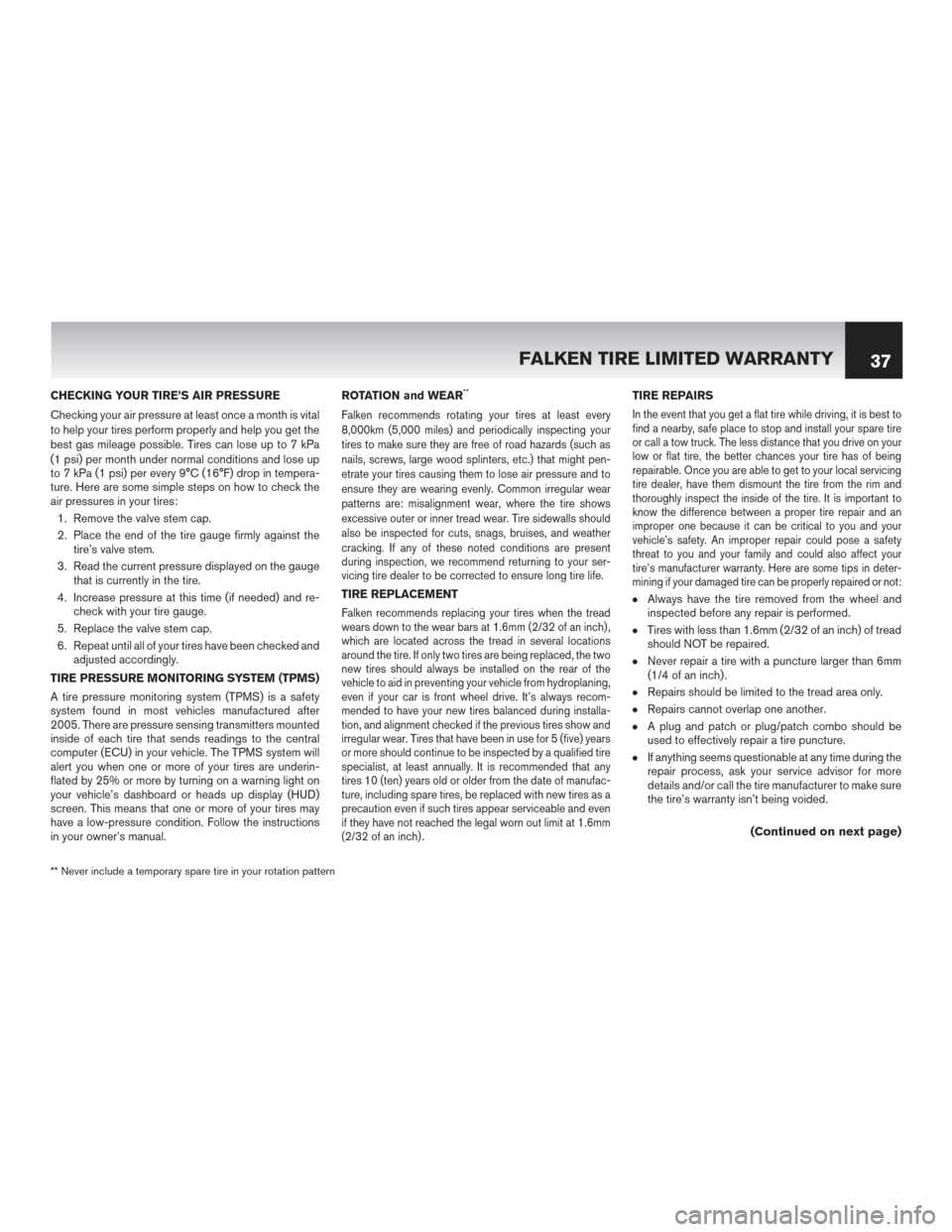
CHECKING YOUR TIRE’S AIR PRESSURE
Checking your air pressure at least once a month is vital
to help your tires perform properly and help you get the
best gas mileage possible. Tires can lose up to 7 kPa
(1 psi) per month under normal conditions and lose up
to 7 kPa (1 psi) per every 9°C (16°F) drop in tempera-
ture. Here are some simple steps on how to check the
air pressures in your tires:1. Remove the valve stem cap.
2. Place the end of the tire gauge firmly against the tire’s valve stem.
3. Read the current pressure displayed on the gauge that is currently in the tire.
4. Increase pressure at this time (if needed) and re- check with your tire gauge.
5. Replace the valve stem cap.
6. Repeat until all of your tires have been checked and adjusted accordingly.
TIRE PRESSURE MONITORING SYSTEM (TPMS)
A tire pressure monitoring system (TPMS) is a safety
system found in most vehicles manufactured after
2005. There are pressure sensing transmitters mounted
inside of each tire that sends readings to the central
computer (ECU) in your vehicle. The TPMS system will
alert you when one or more of your tires are underin-
flated by 25% or more by turning on a warning light on
your vehicle’s dashboard or heads up display (HUD)
screen. This means that one or more of your tires may
have a low-pressure condition. Follow the instructions
in your owner’s manual. ROTATION and WEAR**
Falken recommends rotating your tires at least every
8,000km (5,000 miles) and periodically inspecting your
tires to make sure they are free of road hazards (such as
nails, screws, large wood splinters, etc.) that might pen-
etrate your tires causing them to lose air pressure and to
ensure they are wearing evenly. Common irregular wear
patterns are: misalignment wear, where the tire shows
excessive outer or inner tread wear. Tire sidewalls should
also be inspected for cuts, snags, bruises, and weather
cracking. If any of these noted conditions are present
during inspection, we recommend returning to your ser-
vicing tire dealer to be corrected to ensure long tire life.
TIRE REPLACEMENT
Falken recommends replacing your tires when the tread
wears down to the wear bars at 1.6mm (2/32 of an inch) ,
which are located across the tread in several locations
around the tire. If only two tires are being replaced, the two
new tires should always be installed on the rear of the
vehicle to aid in preventing your vehicle from hydroplaning,
even if your car is front wheel drive. It’s always recom-
mended to have your new tires balanced during installa-
tion, and alignment checked if the previous tires show and
irregular wear. Tires that have been in use for 5 (five) years
or more should continue to be inspected by a qualified tire
specialist, at least annually. It is recommended that any
tires 10 (ten) years old or older from the date of manufac-
ture, including spare tires, be replaced with new tires as a
precaution even if such tires appear serviceable and even
if they have not reached the legal worn out limit at 1.6mm
(2/32 of an inch) .
TIRE REPAIRS
In the event that you get a flat tire while driving, it is best to
find a nearby, safe place to stop and install your spare tire
or call a tow truck. The less distance that you drive on your
low or flat tire, the better chances your tire has of being
repairable. Once you are able to get to your local servicing
tire dealer, have them dismount the tire from the rim and
thoroughly inspect the inside of the tire. It is important to
know the difference between a proper tire repair and an
improper one because it can be critical to you and your
vehicle’s safety. An improper repair could pose a safety
threat to you and your family and could also affect your
tire’s manufacturer warranty. Here are some tips in deter-
mining if your damaged tire can be properly repaired or not:
●Always have the tire removed from the wheel and
inspected before any repair is performed.
●Tires with less than 1.6mm (2/32 of an inch) of tread
should NOT be repaired.
●Never repair a tire with a puncture larger than 6mm
(1/4 of an inch) .
●Repairs should be limited to the tread area only.
●Repairs cannot overlap one another.
●A plug and patch or plug/patch combo should be
used to effectively repair a tire puncture.
●If anything seems questionable at any time during the
repair process, ask your service advisor for more
details and/or call the tire manufacturer to make sure
the tire’s warranty isn’t being voided.
(Continued on next page)
** Never include a temporary spare tire in your rotation pattern
FALKEN TIRE LIMITED WARRANTY 37
Page 42 of 77
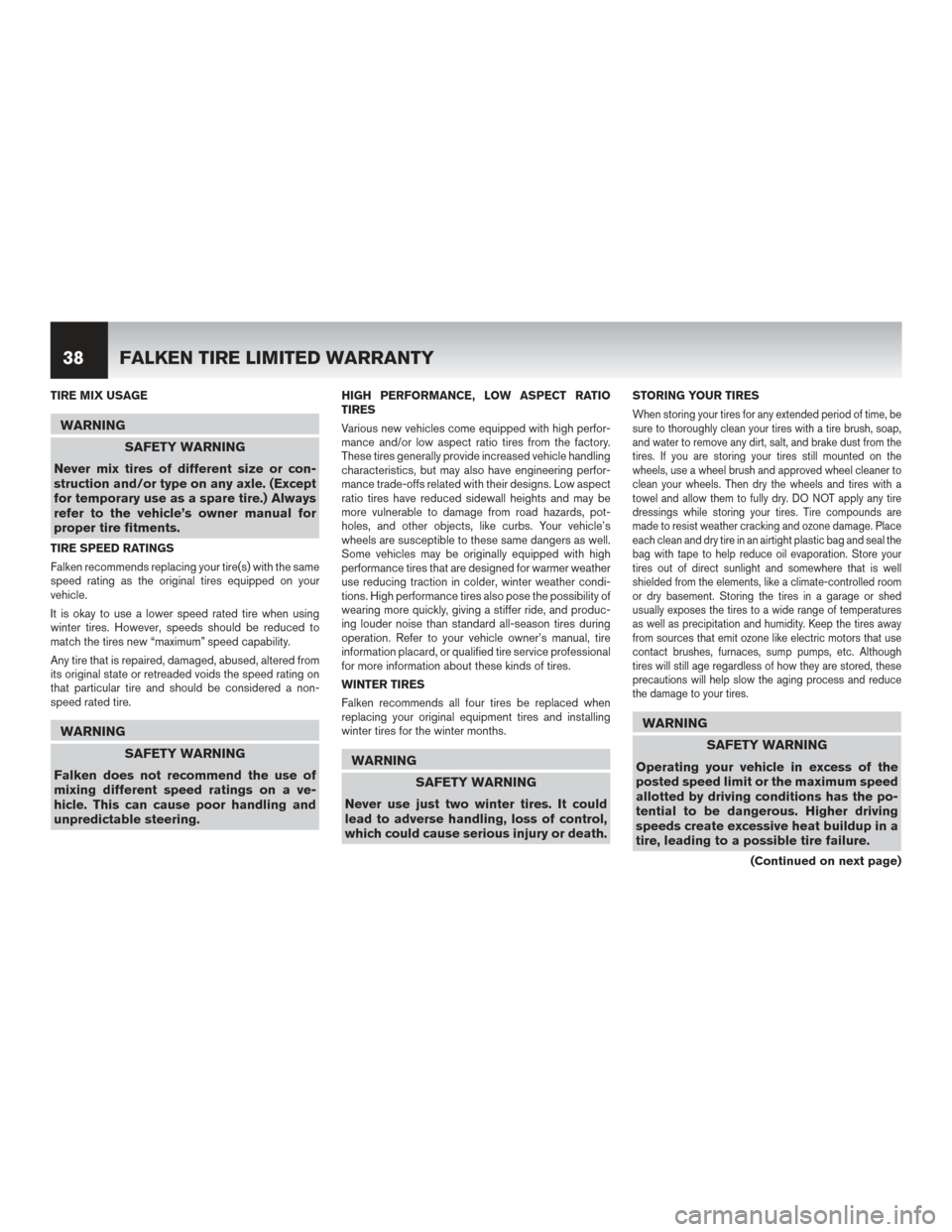
TIRE MIX USAGE
WARNINGSAFETY WARNING
Never mix tires of different size or con-
struction and/or type on any axle. (Except
for temporary use as a spare tire.) Always
refer to the vehicle’s owner manual for
proper tire fitments.
TIRE SPEED RATINGS
Falken recommends replacing your tire(s) with the same
speed rating as the original tires equipped on your
vehicle.
It is okay to use a lower speed rated tire when using
winter tires. However, speeds should be reduced to
match the tires new “maximum” speed capability.
Any tire that is repaired, damaged, abused, altered from
its original state or retreaded voids the speed rating on
that particular tire and should be considered a non-
speed rated tire.
WARNING SAFETY WARNING
Falken does not recommend the use of
mixing different speed ratings on a ve-
hicle. This can cause poor handling and
unpredictable steering.
HIGH PERFORMANCE, LOW ASPECT RATIO
TIRES
Various new vehicles come equipped with high perfor-
mance and/or low aspect ratio tires from the factory.
These tires generally provide increased vehicle handling
characteristics, but may also have engineering perfor-
mance trade-offs related with their designs. Low aspect
ratio tires have reduced sidewall heights and may be
more vulnerable to damage from road hazards, pot-
holes, and other objects, like curbs. Your vehicle’s
wheels are susceptible to these same dangers as well.
Some vehicles may be originally equipped with high
performance tires that are designed for warmer weather
use reducing traction in colder, winter weather condi-
tions. High performance tires also pose the possibility of
wearing more quickly, giving a stiffer ride, and produc-
ing louder noise than standard all-season tires during
operation. Refer to your vehicle owner’s manual, tire
information placard, or qualified tire service professional
for more information about these kinds of tires.
WINTER TIRES
Falken recommends all four tires be replaced when
replacing your original equipment tires and installing
winter tires for the winter months.
WARNING SAFETY WARNING
Never use just two winter tires. It could
lead to adverse handling, loss of control,
which could cause serious injury or death.
STORING YOUR TIRES
When storing your tires for any extended period of time, be
sure to thoroughly clean your tires with a tire brush, soap,
and water to remove any dirt, salt, and brake dust from the
tires. If you are storing your tires still mounted on the
wheels, use a wheel brush and approved wheel cleaner to
clean your wheels. Then dry the wheels and tires with a
towel and allow them to fully dry. DO NOT apply any tire
dressings while storing your tires. Tire compounds are
made to resist weather cracking and ozone damage. Place
each clean and dry tire in an airtight plastic bag and seal the
bag with tape to help reduce oil evaporation. Store your
tires out of direct sunlight and somewhere that is well
shielded from the elements, like a climate-controlled room
or dry basement. Storing the tires in a garage or shed
usually exposes the tires to a wide range of temperatures
as well as precipitation and humidity. Keep the tires away
from sources that emit ozone like electric motors that use
contact brushes, furnaces, sump pumps, etc. Although
tires will still age regardless of how they are stored, these
precautions will help slow the aging process and reduce
the damage to your tires.
WARNING SAFETY WARNING
Operating your vehicle in excess of the
posted speed limit or the maximum speed
allotted by driving conditions has the po-
tential to be dangerous. Higher driving
speeds create excessive heat buildup in a
tire, leading to a possible tire failure.
(Continued on next page)
38 FALKEN TIRE LIMITED WARRANTY
Page 43 of 77
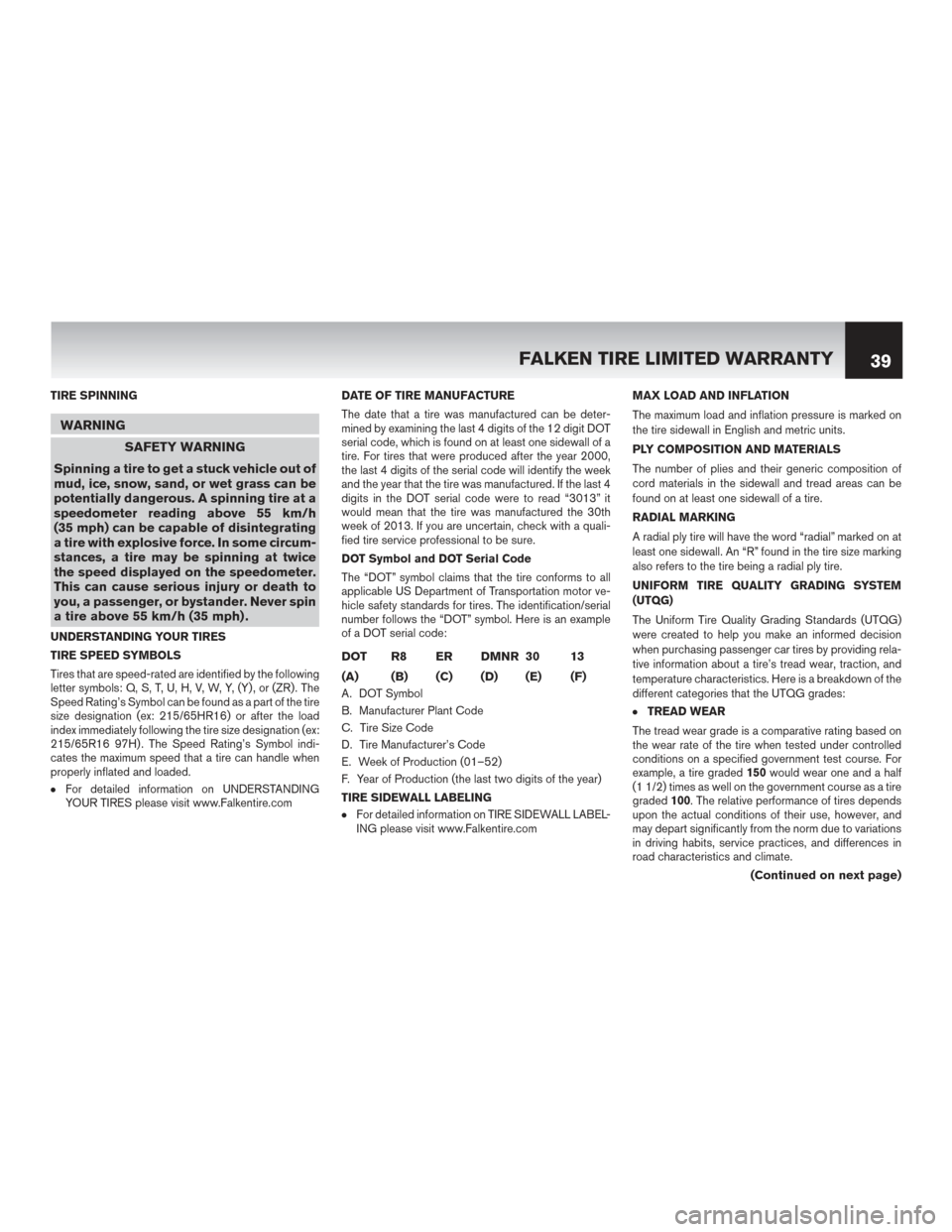
TIRE SPINNING
WARNINGSAFETY WARNING
Spinning a tire to get a stuck vehicle out of
mud, ice, snow, sand, or wet grass can be
potentially dangerous. A spinning tire at a
speedometer reading above 55 km/h
(35 mph) can be capable of disintegrating
a tire with explosive force. In some circum-
stances, a tire may be spinning at twice
the speed displayed on the speedometer.
This can cause serious injury or death to
you, a passenger, or bystander. Never spin
a tire above 55 km/h (35 mph) .
UNDERSTANDING YOUR TIRES
TIRE SPEED SYMBOLS
Tires that are speed-rated are identified by the following
letter symbols: Q, S, T, U, H, V, W, Y, (Y) , or (ZR) . The
Speed Rating’s Symbol can be found as a part of the tire
size designation (ex: 215/65HR16) or after the load
index immediately following the tire size designation (ex:
215/65R16 97H) . The Speed Rating’s Symbol indi-
cates the maximum speed that a tire can handle when
properly inflated and loaded.
●For detailed information on UNDERSTANDING
YOUR TIRES please visit www.Falkentire.com DATE OF TIRE MANUFACTURE
The date that a tire was manufactured can be deter-
mined by examining the last 4 digits of the 12 digit DOT
serial code, which is found on at least one sidewall of a
tire. For tires that were produced after the year 2000,
the last 4 digits of the serial code will identify the week
and the year that the tire was manufactured. If the last 4
digits in the DOT serial code were to read “3013” it
would mean that the tire was manufactured the 30th
week of 2013. If you are uncertain, check with a quali-
fied tire service professional to be sure.
DOT Symbol and DOT Serial Code
The “DOT” symbol claims that the tire conforms to all
applicable US Department of Transportation motor ve-
hicle safety standards for tires. The identification/serial
number follows the “DOT” symbol. Here is an example
of a DOT serial code:
DOT R8 ER DMNR 30 13
(A) (B) (C) (D) (E) (F)
A. DOT Symbol
B. Manufacturer Plant Code
C. Tire Size Code
D. Tire Manufacturer’s Code
E. Week of Production (01–52)
F. Year of Production (the last two digits of the year)
TIRE SIDEWALL LABELING
●For detailed information on TIRE SIDEWALL LABEL-
ING please visit www.Falkentire.com MAX LOAD AND INFLATION
The maximum load and inflation pressure is marked on
the tire sidewall in English and metric units.
PLY COMPOSITION AND MATERIALS
The number of plies and their generic composition of
cord materials in the sidewall and tread areas can be
found on at least one sidewall of a tire.
RADIAL MARKING
A radial ply tire will have the word “radial” marked on at
least one sidewall. An “R” found in the tire size marking
also refers to the tire being a radial ply tire.
UNIFORM TIRE QUALITY GRADING SYSTEM
(UTQG)
The Uniform Tire Quality Grading Standards (UTQG)
were created to help you make an informed decision
when purchasing passenger car tires by providing rela-
tive information about a tire’s tread wear, traction, and
temperature characteristics. Here is a breakdown of the
different categories that the UTQG grades:
●TREAD WEAR
The tread wear grade is a comparative rating based on
the wear rate of the tire when tested under controlled
conditions on a specified government test course. For
example, a tire graded 150would wear one and a half
(1 1/2) times as well on the government course as a tire
graded 100. The relative performance of tires depends
upon the actual conditions of their use, however, and
may depart significantly from the norm due to variations
in driving habits, service practices, and differences in
road characteristics and climate.
(Continued on next page)
FALKEN TIRE LIMITED WARRANTY 39
Page 44 of 77
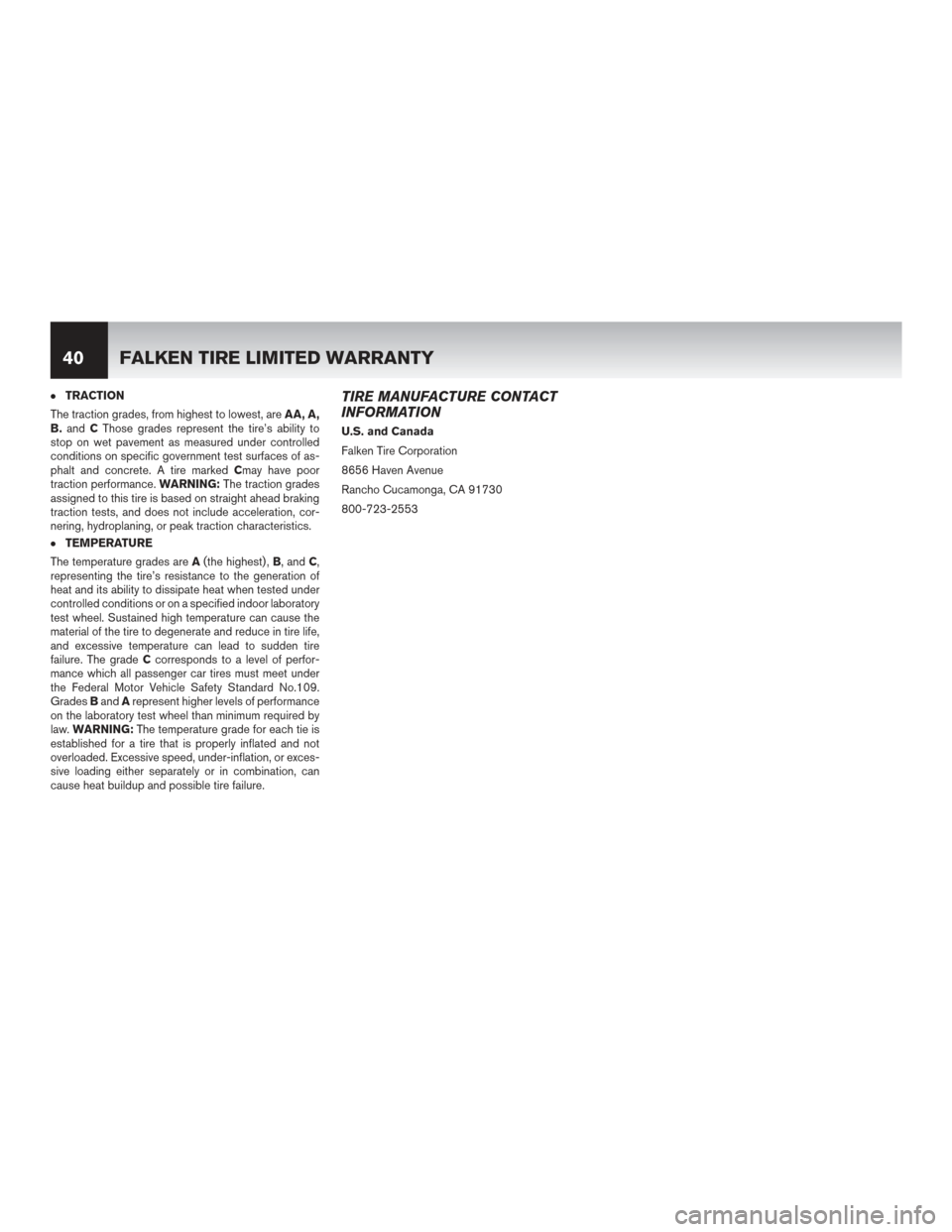
●TRACTION
The traction grades, from highest to lowest, are AA, A,
B. and CThose grades represent the tire’s ability to
stop on wet pavement as measured under controlled
conditions on specific government test surfaces of as-
phalt and concrete. A tire marked Cmay have poor
traction performance. WARNING:The traction grades
assigned to this tire is based on straight ahead braking
traction tests, and does not include acceleration, cor-
nering, hydroplaning, or peak traction characteristics.
●TEMPERATURE
The temperature grades are A(the highest) , B, andC,
representing the tire’s resistance to the generation of
heat and its ability to dissipate heat when tested under
controlled conditions or on a specified indoor laboratory
test wheel. Sustained high temperature can cause the
material of the tire to degenerate and reduce in tire life,
and excessive temperature can lead to sudden tire
failure. The grade Ccorresponds to a level of perfor-
mance which all passenger car tires must meet under
the Federal Motor Vehicle Safety Standard No.109.
Grades Band Arepresent higher levels of performance
on the laboratory test wheel than minimum required by
law. WARNING: The temperature grade for each tie is
established for a tire that is properly inflated and not
overloaded. Excessive speed, under-inflation, or exces-
sive loading either separately or in combination, can
cause heat buildup and possible tire failure.
TIRE MANUFACTURE CONTACT
INFORMATION
U.S. and Canada
Falken Tire Corporation
8656 Haven Avenue
Rancho Cucamonga, CA 91730
800-723-2553
40 FALKEN TIRE LIMITED WARRANTY